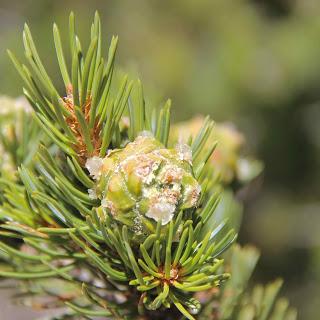 This month I have no news about the serviceberry I’m following. I’m far from home, in a warmer drier land. So instead, here’s a report of a tree I came across on a narrow precipitous ridge crest, holding a boulder in its roots! This was curious enough in itself, but just as interesting were the thoughts it brought to mind. I realized this tree was keeping the boulder from continuing a trip that had started maybe sixty million years ago. Trapped by the tree, it couldn’t make the next leg—a steep 2000-foot descent to the Green River. But the delay would be minor, basically imperceptible. Even five hundred years of imprisonment would be but a fleeting obstacle in this boulder’s journey.
This month I have no news about the serviceberry I’m following. I’m far from home, in a warmer drier land. So instead, here’s a report of a tree I came across on a narrow precipitous ridge crest, holding a boulder in its roots! This was curious enough in itself, but just as interesting were the thoughts it brought to mind. I realized this tree was keeping the boulder from continuing a trip that had started maybe sixty million years ago. Trapped by the tree, it couldn’t make the next leg—a steep 2000-foot descent to the Green River. But the delay would be minor, basically imperceptible. Even five hundred years of imprisonment would be but a fleeting obstacle in this boulder’s journey.
Next leg of the trip—down to the Green River, 2000 feet below the ridge crest.
This is not a local rock—not sandstone, siltstone nor shale. It’s hard tough quartzite, which is why it survived the long punishing journey that started 60 million years ago in the high country of a newly-created mountain range to the north. A fragment of bedrock—perhaps broken by folding, faulting, or frost—was carried many miles by streams, bumped and bashed, worn smooth and round, and left here.
The rock itself is far older than the mountain range. It began as sand in a deep rift valley, 700 million years ago.
For maybe 30 million years, weathering and erosion chipped away at the mountains, reducing them to sand, dirt and pieces of rock. That’s typical—as soon as mountains rise, demolition begins. “Mountains seem massive, abiding and immutable … yet if we look carefully at rocks, if we use them to peer into the past and conjure up the world they came from, we find that mountains too are ephemeral.”
The piles of sand, rock and dirt along the trail used to be part of a mountain range.
The amount of debris carried down and deposited was so immense that the mountain range was largely buried in its own rubble. Probably only the highest peaks stood above extensive gently-sloping surfaces. Then the land rose again—not as mountains, but the entire region. Erosion went back to work, this time exhuming the old buried landscape. It removed much of the debris deposited just a few million years before, but not all. Relic patches remain today on high surfaces—like the narrow precipitous ridge I walked. But unless things change, this too will be gone.In the meantime, the quartzite boulder will have to wait a bit, because hundreds of years ago a pine seedling managed to get established and now has grown large. Its roots grew down into the pile of debris, circumvented the quartzite boulder, and trapped it. Though trail construction exposed the boulder, it can’t roll down to the Green River just yet. It has to wait until the tree dies and the roots decay. But given the scale of its life, I doubt that it feels the least bit impatient.







